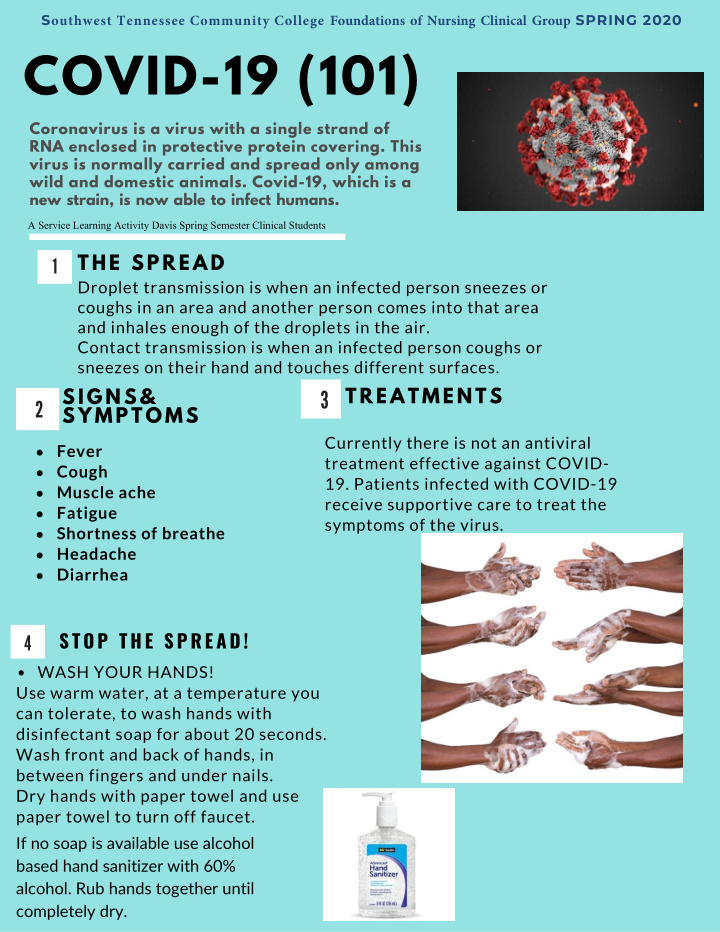



S outhwest Tennessee Community College Foundations of Nursing Clinical Group SPRING 2020 COVID-19 (101) Coronavirus is a virus with a single strand of RNA enclosed in protective protein covering. This virus is normally carried and spread only among wild and domestic animals. Covid-19, which is a new strain, is now able to infect humans. A Service Learning Activity Davis Spring Semester Clinical Students T H E S P R E A D 1 Droplet transmission is when an infected person sneezes or coughs in an area and another person comes into that area and inhales enough of the droplets in the air. Contact transmission is when an infected person coughs or sneezes on their hand and touches different surfaces. S I G N S & T R E A T M E N T S S Y M P T O M S 3 2 Currently there is not an antiviral Fever treatment effective against COVID- Cough 19. Patients infected with COVID-19 Muscle ache receive supportive care to treat the Fatigue symptoms of the virus. Shortness of breathe Headache Diarrhea S T O P T H E S P R E A D ! 4 WASH YOUR HANDS! Use warm water, at a temperature you can tolerate, to wash hands with disinfectant soap for about 20 seconds. Wash front and back of hands, in between fingers and under nails. Dry hands with paper towel and use paper towel to turn off faucet. If no soap is available use alcohol based hand sanitizer with 60% alcohol. Rub hands together until completely dry.
• • • COUGH/SNEEZE IN A TISSUE Cough or sneeze into a tissue or paper towel, then discard immediately into trash. If tissue is not available, cough or sneeze into inner elbow. Then follow with proper hand washing or sanitizing. Should I wear a mask and gloves? You only need to wear a mask if you are ill or experiencing symptoms of COVID-19. Gloves should not be used for long periods of time because they can transfer germs from one surface to the next . They should be changed after each potential surface touched. Proper use of personal protective equipment like gloves and masks are important in avoiding infection. Special precautions for those who are immunocompromised: Self Isolation - Treat everyone as if they are infected and maintain social distancing requirements when in public places. Wash hands and disinfect commonly used surfaces more frequently. Consider getting plastic utensils for your own use. Germs can remain on surfaces and items for up to 72 hours. Suggested Medication It has been suggested that the prophylactic medicine named Chloroquine and Hydroxychloroquine could be used to potentially treat positive COVID-19 patien ts. They are classified as antimalarials . These drug s are used to inhibit protein synthesis thus causing the death of parasitic protozoan such as malaria. They may also be used to to treat inflammation in the body targeted toward autoimmune diseases like rheumatoid arthritis and lupus.
Adverse Reactions & Side Effects Side effects of th ese medication s may include retinal damage, blindness, seizures, cardiomyopathy, agitation, anxiety, depression, confusion, hepatitis, leukopenia and agranulocytosis (low white blood cell count). Adverse reactions to consider while taking th i s medicine is the chance of decreased white blood cells in your body. Decreased WBCs increase the chances of your body receiving an infection. Cardiomyopathy is an adverse effect indicated by abnormal heart rate and rhythm, coughing, shortness of breath and chest pain. · Labwork Monitor WBC or platelet count. This medication could also increase liver enzyme levels. Observe for any development of rash and discontinue at the 1st sight of skin reaction. References Adhikari, S. P., Meng, S., Wu, Y.-J., Mao, Y.-P., Ye, R.-X., Wang, Q.-Z., ...Zhou, H. (2020). Epidemiology, causes, clinical manifestation and diagnosis, prevention and control of coronavirus disease (COVID-19) during the early outbreak period: a scoping review. Infectious Diseases of Poverty, 9(1), NA. Hinkle, J.L., & Cheever, K.H. (2014). Brunner & Suddarth's Textbook of Medical- Surgical Nursing (13th Edition). Wolters Kluwer Lippincott Williams & Wilkins. Quiring,C., Sanoski, C.A., & Vallerand, A.H. (2019). Chloriquine. In Davis's Drug Guide (16th Edition). F.A. Davis Company. Retrieved March 28, 2020
Recommend
More recommend